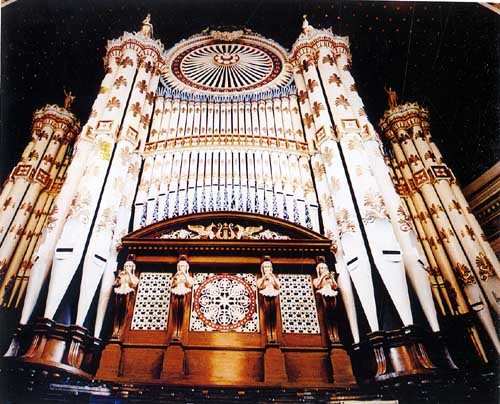Dan Potts reviews another Organ Recital at Leeds Town Hall: Simon Lindley. 24th September 2012 …
In the review, supplied by this ‘pen’, of the Romantic Organ Masterworks recital of 26th August at Leeds Minster, a degree of frustration at the restriction on audience appreciation may have been detectable. We were in Church and much needed cathartic applause came only at the close of a multi-faceted and virtuoso tour. No such pressure was applied in the case of Monday’s audience at Leeds Town Hall; and perhaps because of these secular-sanctioned punctuations, the intensity of the event was much decreased. On comparison, the atmosphere of this recital was more tranquil and relaxed, but so was the applause. It seems, then, that Town Hall concerts are to be comparatively recommended to those of a nervous disposition for a no less inspiring experience. The city organist – Dr. Simon Lindley – was at the keyboard again; and to say this does not do justice to the ocular feast that consists of watching a highly energetic man all in black, shifting, thrashing and grasping away at what appears to be the helm of the highly florid and ornate spacecraft that is the Victoria Hall. Think the Wizard of Oz revealed through a kaleidoscope. His oral contribution between these psychedelic navigations was, as ever, humorous, intriguing and informative.
Elgar’s ‘Imperial March’ opened the recital and was an excellent choice for this function. An arresting tour of what seemed ironic, Imperial nostalgia, especially given the relaxed informality of the event, compounded the composer’s ambivalence toward such associations. Sequences of suspensions, typical of the composer, were played with unique delicacy of measure and never pulled about with vulgarity. Sections contrasting in timbre showed off the versatility of the organ, and were lent modest charm in being arranged for the instrument. From Worcester we moved to Bradford in Fenby’s arrangement of Delius’s ‘On hearing the First Cuckoo in Spring’. Anodyne warmth swelled the heart with Springtime promise in the knowledge that we now enter the darker months of the year. In lulling six-eight time, and with crispy timbres, a Norwegian folk song could be heard; and as repeated figures over differing harmonic permutations descended in sequence the lulling cuckoo itself was discernible. Next came ‘Cavatina’, the result of a Coleridge Taylor – Reginald Goss Custard collaboration. Hymn-like at times, and very English, the melodic line was also somewhat reminiscent of an aria, perhaps from an opera. Tasteful and measured ritardandos brought this short, simple piece to its close.
Grainger came next with a toccata-like clog-dance of a piece that both arrested and soothed: ‘Handel in the Strand’. Arresting for the nigh perfect accuracy of complex and rapid dexterous execution. Soothing for the repetition of such figures over sustained and simple descending passages. The many timbral shifts charmed the listener both sonically, and for the aforementioned shifting, thrashing and grasping of the organist at the stops. Two ‘Chorale Preludes: Rockingham – Melcombe’ by Parry followed the Grainger. The audience was advised by Lindley before the performance of these two pieces that “if the Grainger did wake you up, these two shall send you nicely to sleep”. Certainly, the piano polyphony of Rockingham soothed with very English sounding suspensions; and relaxed sighing was the effect of the folk-like Melcombe where sustained pedals gave grounding to simple forays into resolved dissonances. The rapid toccata-like pieces are always a treat. However, two many of them without contrast would be overkill. The balance here is good therefore.
‘Suite Gothique’ was the four-movement treat by Boellmann that came next and was the piece that stood out from the rest. The first three movements laid the ground with a winding-down effect toward the fourth, which was an alarming and arresting ‘Toccata’. The first movement, ‘Introduction/Choral’, gave a hint of the excitement to come with its grandiose major-minor shifts, sometimes resolving on a major root, only to be followed by an entry in the relative minor. The second movement was a ‘Menuet-Gothique’, somewhat merry with heavy use of pedals and timbral shifts. The calm before the storm came in the form of the ‘Priere a Notre-Dame’ for the third movement. A slow tranquil movement, development and extension of the main theme created a sense of building towards a goal. In the fourth, we heard the organ at its most impressive through frantic, energized agitation in the treble over skeletal diminished sevenths in the pedals. Unexpected passing modulations confused and irked the ear toward the close.
The penultimate offering was Massenet’s ‘The Last Sleep of the Virgin (La Vierge)’. Well-balanced, lulling six-eight time suggested the peaceful slumber of the Virgin on the night, as we were informed, before her bodily assumption into heaven. The sense of peace imparted brings with it connotations of the attempt at psychological satisfaction for believers entailed by the Assumption, at least on a Jungian reading. Contrasting in style, although, perhaps, not entirely different in the Jungian connotations of the subject matter was Walton’s ‘Coronation March: Orb and Sceptre’. Highly recognizable as a stirring piece written for the coronation of Elizabeth II, awkward confusion must have arisen in the hearts of even the staunchest of republicans as they became swathed in layer of goose bumps.
